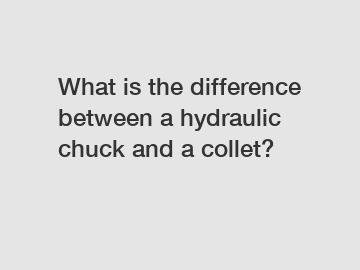What is the difference between a hydraulic chuck and a collet?
What is the difference between a hydraulic chuck and a collet?
If you are involved in machining or any sort of precision work, you may have come across the terms hydraulic chuck and collet. These are two common tools used to secure cutting tools, such as drills or end mills, in machining centers or lathes. While both serve the purpose of holding tools in place, there are important differences between them. Let's delve deeper into this topic to understand the dissimilarities and advantages of each.
1. Operation:

- Hydraulic Chucks: A hydraulic chuck uses hydraulic pressure to secure a tool. It consists of a hollow body with a piston inside. When the pressure is applied, the piston moves forward, gripping the tool tightly. Hydraulic chucks offer excellent clamping force and are suitable for heavy-duty machining applications.
- Collets: Collets, on the other hand, are typically cylindrical metal sleeves with internal threads or grooves. They rely on a collet nut to compress the collet around the tool, holding it in place. Collets provide a uniform pressure distribution around the tool and are preferred for high-precision applications.
2. Tool Holding Capability:
- Hydraulic Chucks: Hydraulic chucks excel in the firm gripping of tools, making them ideal for heavy cuts and high-speed operations. They offer excellent balance and minimal runout, ensuring precise machining results. Hydraulic chucks are often used in applications where tool vibration or slippage is a concern.
- Collets: Collets are versatile and can accommodate a wide range of tool sizes. They provide good tool concentricity and are widely used in applications that require high accuracy and repeatability. Collets are commonly found in milling machines, lathes, and routers.
3. Tool Changing:
- Hydraulic Chucks: Changing tools in a hydraulic chuck can be relatively time-consuming. Since the hydraulic pressure needs to be released before the tool can be swapped, it can add to the overall machining time.
- Collets: Collets offer faster tool changing capabilities. By simply loosening the collet nut, the tool can be easily swapped. This is advantageous in scenarios where frequent tool changes are required, improving overall productivity.
4. Maintenance and Costs:
- Hydraulic Chucks: Hydraulic chucks are more complex in design and require periodic maintenance. The seals and hydraulic components need to be inspected and replaced as necessary. They are generally more expensive upfront but offer significant benefits in terms of tool holding capabilities and machining performance.
- Collets: Collets are relatively simple in design and require minimal maintenance. They are less expensive compared to hydraulic chucks, making them a cost-effective solution for many machining applications.
In conclusion, while both hydraulic chucks and collets serve the purpose of holding tools, they differ significantly in their operation, tool holding capability, tool changing speed, maintenance requirements, and costs. The choice between a hydraulic chuck and a collet depends on the specific machining requirements, such as the nature of the work, desired precision, and the need for frequent tool changes. By understanding their differences and advantages, you can make an informed decision to optimize your machining processes and achieve the desired results.
If you are looking for more details, kindly visit 5 Jaw Power Chuck, cnc 4 jaw chuck price, c6136.

Comments